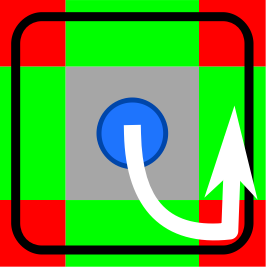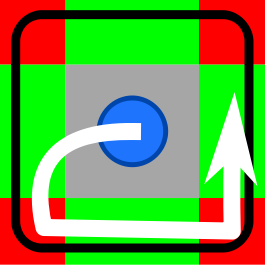Pad vs Stick vs Leverless
The age old question... which one is better? Should you switch to leverless like all the cool kids? Continue to blame them and their cheatboxes like all the boomers? And why do controller users keep winning majors?
One of the goals of this site was to answer that (at least for myself) using objective measurements, and this is what I have concluded:
Pad
Fast but inaccurate by default. You improve with focused effort on cleaning up your inputs. Use pad if you gotta go fast.
"Fast" in this definition is not just your input speed, but also how fast you get there. You can achieve competitive results very quickly on pad.
You also have quick and simple access to 8 buttons spread across multiple fingers which can allow you to take advantage of extra button binding.
However the first issue is getting a reliable motion input on a D-pad requires you to give up some speed and practice them slowly.
The second issue with pad is no great ones exist for fighting games in Feb 2025, every one is a compromise. The original purpose of this website before it got sidetracked into a general input trainer was to compare D-pads and find the best pad, which for me are:
- Xbox Series X|S - The best D-pad and good build quality, but has analog triggers. This is the only D-pad that I found that is tactile with a true full contact pivot point. It's also annoyingly loud and clicky.
- Betop C3 - Extremely cheap on AliExpress, but also extremely cheap build quality. A sort of mushy and slow D-pad that is fun to use. No access to L3/R3 buttons.
- 8bitdo M30 - Great build quality, but non uniform button shapes and a D-pad that is a bit too sensitive on diagonals.
Reliable D-pad Diagonals
A diagonal requires triggering two cardinal switches. To trigger one cardinal direction you might need to only rotate the pad 2 degrees, but to trigger two you need to push it 2.8 degrees into the corner.
This is a 40% greater distance. You can't just apply even pressure in a circle to get a diagonal, you must push it extra far into corners.
This may require intentionally slowing down your movements to ensure you hit the corners, or finding a hand techique that works for you.
Stick
Slow but accurate by default. You improve by just using it more as speed comes naturally. Use stick if you believe slow and steady wins the race.
In the beginning, stick is harder for very simple things like just moving without accidentally jumping, and easier (relatively) for complex motions like 360s. But it's also easier to learn simple things than complex things. This makes the learning curve weird, where all things are equally hard and improve at the same rate.
It also feels hefty, and until you learn how to move it, it is kind of slow. But for me, this slowness turned out to be a feature. I have a tendancy to rush inputs under pressure, and the stick slowing me down meant my accuracy was immediately better than all other devices, which was more pronounced in game. It's pretty much impossible to move the stick so fast you miss inputs.
Speed also does come eventually, after a few months you can reach speed parity with pad for many actions. Some actions like dashing are slightly faster for me on stick.
Training Stick Diagonals
A diagonal requires triggering two cardinal switches. To trigger one cardinal direction you might need to push the stick 7 degrees, but to trigger two you need to push it 9.8 degrees into the corner. This is a 40% increase in how far you need to push it. The range of stick motion is not a circle, but a square.
Stick switches have deadzones that add a 'stickiness' to inputs and make it easier to hit diagonals in passing. So depending on your stick it may be slightly less strict for actual motion inputs and may be why you feel like you hit diagonals more than you should given their tiny activation area.
In order to get diagonals in the beginning, either ride the gate on a circular/octagonal stick or adjust your motions so they always hit the corner of a square gate:
 |  |
| Quarter Circle | Half Circle |
|---|
Your movements will become more efficient with practice.
If you need a recommendation for levers, my favorite are:
- Crown CWL-309-MJ-NEW-Helpme-KMS-ST30. My favorite lever and the basis of the Open309 project. I use a 309 with a 3D printed squircle collar.
- Seimitsu SELS-70X-S. My favorite Japanese style. You will need the SE plate to use in a sanwa mount.
Stick Tricks
There are advanced techniques that make some stick inputs faster than any other device.
- Fast dash. The idea is to hit the stick with two parts of your hand in succession. E.g. you can dash right by first pushing with your thumb, and then with your palm. You can also do something similar to the heel toe techique drummers do, to effectively double your input speed by first using your wrist muscle and then arm.
- Fast left->right or right->left inputs. You can achieve a perfect two frame motion by doing a similar technique to the fast dash, except you rotate your wrist to push it in both directions in succession very quickly.
These are unnecessary, very difficult to practice in both directions, and mostly for sweatlords.
Modding
The only thing more fun than using a stick is modding it, and you will go down a rabbit hole of replacing springs/grommets and buttons. The Open309 project readme goes over how to tune a stick in excruciating detail.
Leverless
When used naïvely, it is the slowest. When used with SOCD shortcuts it is the fastest. Use leverless if you like the idea of labbing for character-specific advantages.
The leverless learning curve is the opposite of stick. In the beginning simple actions like moving and jumping are trivial. Basic motion inputs (DPs, QCs) are hard. And complex motion inputs (Strict HCs, 360s, 720s) are very hard. This is not to say these are impossible, they just took me more practice than other devices to get to the same level of proficiency.
The speed of your inputs seem to be based on how many things you have to coordinate, with each "mental step" taking 3-4 frames. To input something like a quarter circle motion you can do it multiple ways:
| Press Down, Press Right, Release Down | 9-12 frames |
| Press Down, Roll to Right | 6-8 frames |
| Chord everything with an SOCD shortcut | 3-4 frames |
Leverless without SOCD shortcuts has no inherent advantage over any other device, requires more finger coordination for inputs, and can sometimes be slower (a decent pad/stick QC motion is also 6-8 frames). So if you are going to spend the time practicing, you may as well do it the SOCD way.
The downside to SOCD shortcuts, especially if you are new to fighting games, is they are unintuitive and it will be challenging to learn them and the game at the same time.
Pro player usage of SOCD varies. You can count their input frames in SF6 replays to see how fast they are, and realize it's not a requirement to SOCD everything to win games and that input speed obsession may be a bit overblown.
Here are some videos by Chris_F going over everything you need to learn leverless correctly:
Some games suit leverless better others
Street Fighter is well suited to leverless controller. The most "killer feature" it can do that other devices cannot is a three-frame walking DP SOCD shortcut. This is a very important move to do on reaction, where execution speed is important.
Tekken does not have as many motion inputs, preferring simpler command normals and dash inputs. Some notable inputs it does have:
- Strict Half Circles. Fast rolling your fingers can cause you to miss the down input some of the time. A reliable half circle forward requires flicking back and then an SOCD quarter circle forward shortcut. Check out this video by 'Frame Counting' on the topic.
- Back Neutral Forward. Requiring a middle neutral input is very difficult to achieve reliably. It has the same issues as half circles, fast movements will skip the neutral some of the time. A reliable back neutral forward requires flicking back and pressing forwards, another awkward and slow input. Some of these inputs were removed in Tekken 8.
- Wave Dash. This requires manual timing of the neutral motion, which will require some dedicated practice to do reliably.
- Korean Back Dash. An very simple KBD SOCD shortcut does exist.
Virtua Fighter motions are heavily based on dashes, crouch dashes, half circles, back forward and back down forward motions. These are almost perfectly what leverless is not good at.
All things considered, I don't think the differences between devices are that large. Picking up controller X or Y is not going to make you a better player unless it inspires you to play more. The average speed differences between devices for all inputs is fairly small, 10-20%, and speed itself is only important for reaction-based moves.
What is most important in the long term, is do you like process that the device requires in order for you to improve.
Back to Home©2025 MotionInputs.com